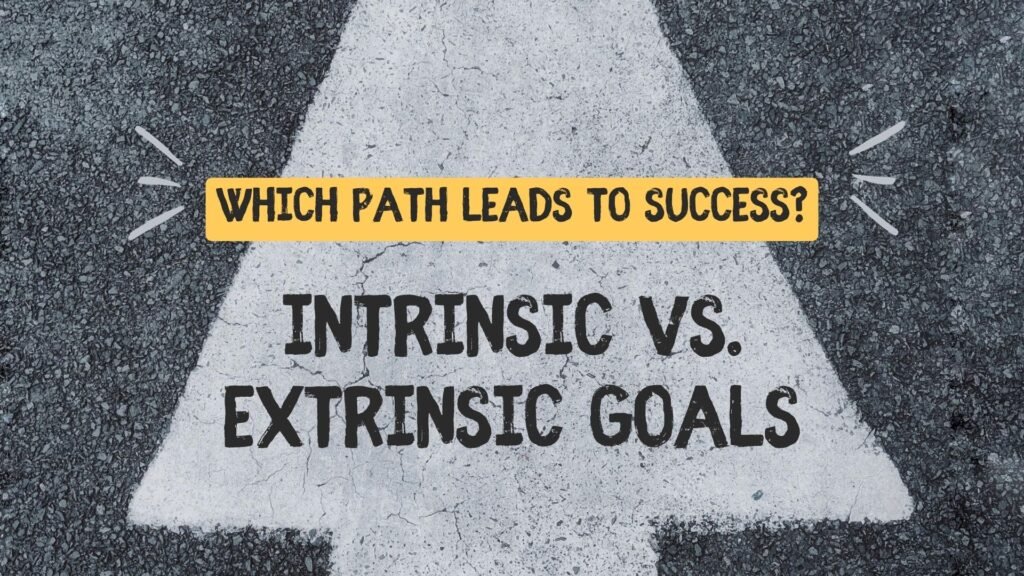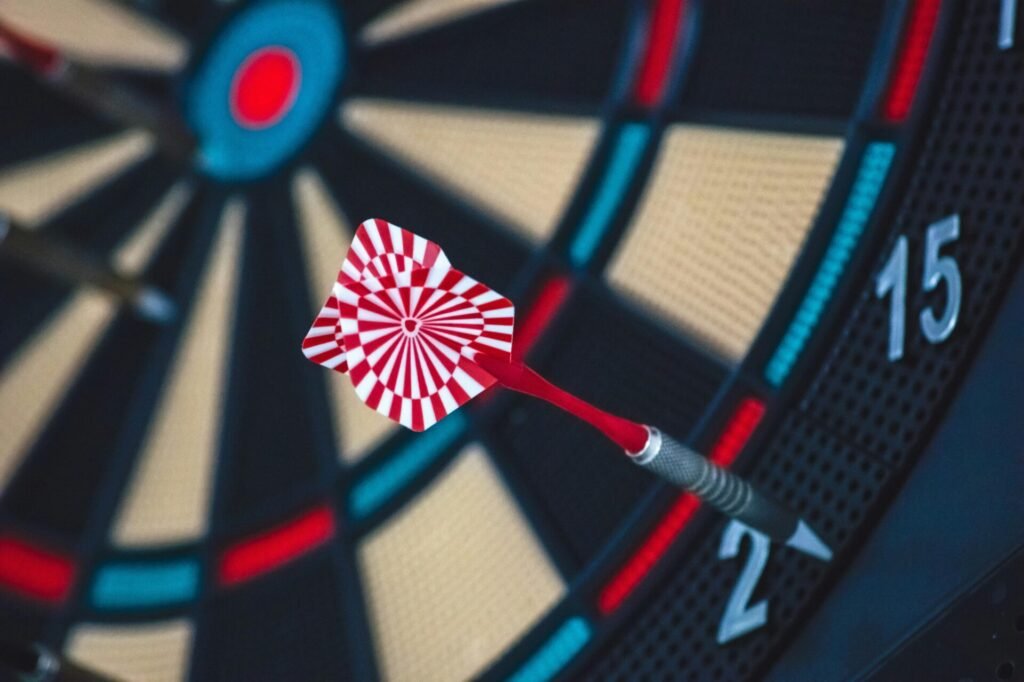Hi beautiful,
Have you ever achieved something you thought would make you happy, but you feel empty inside?
You got promotion, bought that expensive car, or reached 10,000 followers on social media. You did everything right, but something still feels off.
So, what is it that actually brings happiness? The answer lies in why you set certain goals.
This is where intrinsic and extrinsic goals come in.
In this article you’ll learn about intrinsic goals and why they’re so fulfilling. Then, you’ll explore extrinsic goals and their importance.
You’ll uncover how each type impacts your well-being, how to find the right balance, and why it’s crucial for lasting happiness.
Let’s get started.
Goals: A Journey We All Share
We all have goals. Whether you’re a teenager figuring out life or a CEO running a company, goals are what get us out of bed in the morning. They’re the reason that keep us going through ups and downs in life.
But not all goals are created equal. Some fill you with energy and excitement, while others… they just drain you.
Why Our Goals Lead to Disappointment
Many of us set goals based on what society expects or what others think we should do. We chase external markers of success – money, status, recognition – and believe they’ll bring us happiness.
Studies shows that 71% of people who achieve their external goals still feel unfulfilled.
The problem is we pursue goals that don’t align with our true selves. This misalignment leads to:
- Constant feeling of emptiness despite achievements
- Burnout from forcing ourselves to chase things we don’t really want
- Comparison anxiety and never feeling “good enough”
- Loss of motivation once the external reward is achieved
The Solution: Understand Intrinsic vs. Extrinsic Goals
To break out of this cycle, we need to understand the basic difference between intrinsic and extrinsic goals.

Intrinsic Goals
Intrinsic goals come from within. They’re the goals that make you lose track of time because you enjoy the process so much.
For example:
- You learn to play guitar because music moves you, not because your parents forced you
- You help others because it feels right, not for the likes and shares
- You choose a career path because it excites you, not just for the paycheck
Key characteristics of intrinsic goals:
- They energize rather than drain you
- You’d pursue them even if no one else knew
- The journey itself brings satisfaction
- They align with your personal values
- They create lasting fulfillment and you feel genuinely happy when you achieve them
Extrinsic Goals
Extrinsic goals are driven by external rewards or pressures. They’re about getting something in return.
For example:
- Working overtime for a bonus rather than job satisfaction
- Posting perfect photos on social media for the followers
- Choosing a career to impress others rather than personal interest
Key characteristics of extrinsic goals:
- Satisfaction depends on others’ recognition
- The focus is on the end result, not the journey
- You are comparing yourself with others
- Motivation fades after achieving the goal
- You always want more
The Real-World Impact: How Goals Shape Our Lives
Let’s look at how these different types of goals affect various aspects of life:
Career Path
- Intrinsic: Choosing a job that matches your values and interests
- Extrinsic: Selecting a career based solely on salary or prestige
Relationships
- Intrinsic: Building genuine connections based on shared values
- Extrinsic: Networking only with people who can benefit your status
Personal Development
- Intrinsic: Learning new skills because you’re curious
- Extrinsic: Taking courses just to add certificates to your resume
How These Goals Mess With Your Motivation
When It’s From Within (Intrinsic)
Think back to when you were a kid—you did things just for the fun of it. That’s intrinsic motivation.
No one had to bribe you to play your favorite game or read your favorite book. You did it because it made you happy, plain and simple.
When It’s From Outside (Extrinsic)
It feels like you’re always chasing one reward after another, and hope the next one will finally be enough. You work harder, reach the goal, and for a moment, it feels great. But the excitement fades quickly.
What Makes Extrinsic Goals Different?
With extrinsic goals, you look for approval or praise from others. You want people to say, “Wow, you’re amazing!” You need a constant thumbs-up from the world.
While extrinsic goals bring you stuff like money or gadgets, they don’t always bring lasting happiness. You might have lots of cool things, but deep down, you still feel something is missing.
Interesting Fact: A study in the Journal of Personality and Social Psychology found that extrinsic rewards decrease intrinsic motivation over time.
Extrinsic goals focus on getting results fast. You get happiness and satisfaction for a moment, but it doesn’t keep you content in the long run.
Find Your Sweet Spot: Balance Both Types of Goals
You need both types of goals to succeed in life. You don’t have to choose one over the other – but you have to keep the balance.
Here’s how:
- Audit Your Current Goals
- List your goals
- Ask yourself “Why?” three times for each goal
- Notice which answers point to internal vs external motivations
- Align Your Actions
- Identify which activities energize you
- Note when you feel forced vs naturally motivated
- Adjust your goals based on these insights
- Create a Balanced Goal System
- Set primary goals based on internal motivation
- Include necessary external goals but keep them secondary
- Regular review and adjust as needed
Practical Examples
Here’s how to blend both types of goals effectively:
Career Example:
- Intrinsic: Choose a career that uses your natural talents
- Extrinsic: Set clear salary milestones
- Balance: Find a role that offers both meaningful work and fair compensation
Fitness Example:
- Intrinsic: Move your body in ways that feel good
- Extrinsic: Work toward specific strength or endurance targets
- Balance: Set performance goals that align with activities you enjoy
Benefits of Getting It Right
- You’ll enjoy the journey, not just the destination
- Less stress about what others think
- More energy because you’re not fighting yourself
- Better chances of sticking to your goals
Impact of Intrinsic and Extrinsic Goals on Your Life

- Source of Motivation
- Intrinsic Goals: These come from your personal interests and values. You work toward them because they truly mean something to you.
- Extrinsic Goals: These are shaped by outside factors, like social expectations or a desire for rewards,
- Impact on Life: Intrinsic goals lead to a more meaningful and self-driven life because you’re following what truly matters to you. Extrinsic goals, however, make you feel like you’re chasing someone else’s dreams, which can lead to dissatisfaction over time.
- Sustainability
- Intrinsic Goals: These goals usually last longer because they’re in line with your core beliefs.
- Extrinsic Goals: They bring short-term happiness, with satisfaction fading over time.
- Impact on Life: Intrinsic goals offer lasting happiness and a sense of purpose, while extrinsic goals leave you unfulfilled once the initial excitement wears off.
- Impact on Well-being
- Intrinsic Goals: Pursuing these goals is connected to greater happiness, contentment, and overall satisfaction.
- Extrinsic Goals: Chasing extrinsic goals lead to stress, anxiety, and a constant need for external approval.
- Impact on Life: Focusing on intrinsic goals supports mental and emotional health, whereas an overemphasis on extrinsic goals take a toll on well-being.
- Autonomy
- Intrinsic Goals: You have more freedom and control with intrinsic goals, as they align with your own desires.
- Extrinsic Goals: These goals often involve looking for approval from others, which limit your independence.
- Impact on Life: The freedom to pursue what truly matters builds confidence, while relying on external approval feel restrictive.
Also Read: “How to Set SMART Goals: A Step-by-Step Guide“
Wrapping it Up
Albert Einstein said,
“Strive not to be a success, but rather to be of value.”
The most fulfilling life comes from pursuing goals that matter to you, not just those that look good to others.
Start today by examining your goals and ask yourself: “Am I doing this for me, or for someone else?”
Gandhi's words: "Happiness is when what you think, what you say, and what you do are in harmony."
When our inner desires align with our external pursuits, we find true happiness. It’s the place where our passions meet practicality, and our achievements hold significance not just for us but for everyone around us.
How can I tell if a goal is intrinsic or extrinsic?
See where the goal’s motivation comes from. If it comes from your inner desires, it’s intrinsic. If it’s motivated by external things like rewards or what others think, it’s more likely extrinsic.
Can a goal be both intrinsic and extrinsic?
Yes, some goals have a mix of both intrinsic and extrinsic motivation. The important thing is to figure out which one is the main driving force behind the goal.
What are three examples of intrinsic goals?
Three examples of intrinsic goals are personal growth, developing meaningful relationships, and finding a sense of inner fulfillment.
What are three examples of extrinsic goals?
Three examples of extrinsic goals are achieving fame, earning a high salary, and getting social recognition.








Your blog quickly became my go-to place for motivation. I cannot thank you enough!
I am impressed with this internet site, very I am a fan.
With the whole thing which appears to be building inside this specific area, many of your points of view are rather radical. Nonetheless, I appologize, because I can not subscribe to your whole strategy, all be it exhilarating none the less. It would seem to everybody that your comments are not totally rationalized and in actuality you are your self not really totally convinced of the argument. In any event I did enjoy reading it.
I’m still learning from you, but I’m trying to reach my goals. I definitely liked reading all that is written on your site.Keep the posts coming. I loved it!
Excellent blog right here! Additionally your site a lot up fast! What host are you the use of? Can I get your associate hyperlink in your host? I wish my site loaded up as quickly as yours lol
You need to take part in a contest for top-of-the-line blogs on the web. I’ll recommend this website!
Terrific work! That is the type of information that should be shared across the internet. Disgrace on the seek engines for not positioning this put up upper! Come on over and seek advice from my site . Thanks =)
Great work! This is the type of information that should be shared around the internet. Shame on Google for not positioning this post higher! Come on over and visit my web site . Thanks =)
I am not sure where you’re getting your information, however great topic. I must spend a while studying more or working out more. Thanks for wonderful info I was searching for this info for my mission.
Some really fantastic information, Gladiola I detected this. “Things we not hope for often come to pass than things we wish.” by Titus Maccius Plautus.
I conceive this web site has got some really great info for everyone : D.
Great post, you have pointed out some good points, I likewise believe this s a very fantastic website.
I?¦ve read a few excellent stuff here. Definitely price bookmarking for revisiting. I surprise how so much attempt you place to make such a fantastic informative site.
I like what you guys are up also. Such intelligent work and reporting! Keep up the superb works guys I’ve incorporated you guys to my blogroll. I think it’ll improve the value of my site 🙂